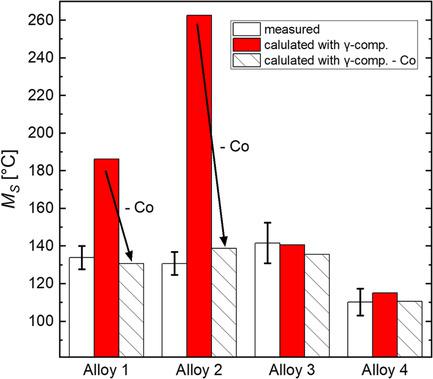当前位置:
X-MOL 学术
›
Steel Res. Int.
›
论文详情
Our official English website, www.x-mol.net, welcomes your feedback! (Note: you will need to create a separate account there.)
Determination of Martensite Start Temperature of High‐Speed Steels Based on Thermodynamic Calculations
Steel Research International ( IF 2.2 ) Pub Date : 2020-06-03 , DOI: 10.1002/srin.202000063 Jan Platl 1 , Harald Leitner 2 , Christoph Turk 2 , Ronald Schnitzer 1
Steel Research International ( IF 2.2 ) Pub Date : 2020-06-03 , DOI: 10.1002/srin.202000063 Jan Platl 1 , Harald Leitner 2 , Christoph Turk 2 , Ronald Schnitzer 1
Affiliation

|
High‐speed steels (HSS) exhibit a microstructure that comprises a martensitic matrix with carbides. Due to the generally high thermal stability of carbides, it is necessary to perform hardening at very high austenitizing temperatures. Nevertheless, there are certain carbides in HSS that are not dissolved. Therefore, the composition of the austenite, which can be transformed into martensite, is significantly different from the alloys’ nominal composition. Consequently, commonly applied formulae for the calculation of martensite start temperature cannot be used for HSS. The current study demonstrates how empirical formulae, which are basically applied for low‐alloyed steels, where no carbides are present at austenitizing temperature, can be modified for high‐alloyed HSS by applying thermodynamic calculations. Thermo‐Calc software is utilized to calculate the composition of the austenite at two different austenitizing temperatures, and with these compositions are calculated subsequently. For experimental verification, of four alloys, which are quenched from these austenitizing temperatures, are determined using dilatometry. The experimental results show good agreement with the corresponding thermodynamic equilibrium calculations. Furthermore, the results reveal that Co does not raise as predicted by the commonly applied empirical formulae. Therefore, adapted formulae for HSS in a wide composition range are proposed.
中文翻译:

基于热力学计算的高速钢马氏体起始温度的确定
高速钢(HSS)的微观结构包括具有碳化物的马氏体基体。由于碳化物通常具有很高的热稳定性,因此必须在很高的奥氏体化温度下进行硬化。但是,HSS中仍有某些碳化物未溶解。因此,可转变为马氏体的奥氏体组成与合金的标称组成明显不同。因此,用于计算马氏体起始温度的常用公式不能用于HSS。当前的研究证明了经验性基本适用于奥氏体化温度下不存在碳化物的低合金钢的公式,可以通过热力学计算修改高合金高速钢的配方。利用Thermo-Calc软件计算两个不同奥氏体化温度下的奥氏体成分,并使用这些成分随后进行计算。为了进行实验验证,使用膨胀法确定了从这些奥氏体化温度淬火的四种合金的含量。实验结果表明与相应的热力学平衡计算吻合良好。此外,结果表明Co不会升高如常用的经验公式所预测。因此,提出了在广泛的组成范围内适用于HSS的公式。
更新日期:2020-06-03
中文翻译:

基于热力学计算的高速钢马氏体起始温度的确定
高速钢(HSS)的微观结构包括具有碳化物的马氏体基体。由于碳化物通常具有很高的热稳定性,因此必须在很高的奥氏体化温度下进行硬化。但是,HSS中仍有某些碳化物未溶解。因此,可转变为马氏体的奥氏体组成与合金的标称组成明显不同。因此,用于计算马氏体起始温度的常用公式不能用于HSS。当前的研究证明了经验性基本适用于奥氏体化温度下不存在碳化物的低合金钢的公式,可以通过热力学计算修改高合金高速钢的配方。利用Thermo-Calc软件计算两个不同奥氏体化温度下的奥氏体成分,并使用这些成分随后进行计算。为了进行实验验证,使用膨胀法确定了从这些奥氏体化温度淬火的四种合金的含量。实验结果表明与相应的热力学平衡计算吻合良好。此外,结果表明Co不会升高如常用的经验公式所预测。因此,提出了在广泛的组成范围内适用于HSS的公式。



























 京公网安备 11010802027423号
京公网安备 11010802027423号